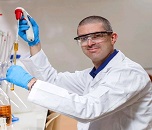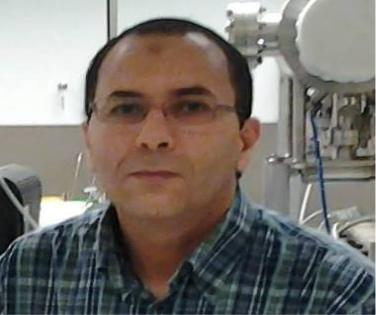Scientific Program
Keynote Session:
Title: Latest trends in Green Chemistry Asphalt Pavement in the Kingdom of Saudi Arabia: Recycled Plastic Waste with a Greener Sustainable Chemistry Binder applied
Biography:
Andrews, K. and Dernayka, S.D.,Prince Mohammad Bin Fahd University, AlKhobar, Kingdom of Saudi Arabia
Abstract:
The purpose of this review is to identify current green chemistry used to modified asphalt binders in the Kingdom of Saudi Arabia (KSA) with the intent to propose a greener eco-friendly binder material to be implemented into current modified asphalt formulations that meet regional specific performance criteria. This review will set up future experimentation in this field that can address the reduced usage of the traditional bitumen formulation for a greener sustainable environment in KSA.
Title: Grafting of Polyaniline by a Dynamic Inverse Emulsion Polymerization Technique onto Membranes as an Anti-Biofouling Agent: An Innovative Approach
Biography:
Group leader of the Laboratory of Polymers, Composites, and Nanocomposites at Kinneret Academic College, Ran is an experienced lecturer, scientist and faculty member of the Water Industries Engineering Department at the Kinneret Academic College since 2013. A Technion graduate with extensive industry experience, Ran has been an industry consultant for many years, leveraging his vast multidisciplinary expertise in polymers, composites, electro-chemical and electro-mechanical sensors and nanomaterials. Currently, he is the CTO of the Kinneret Innovation Center and Obvislim Ltd
Abstract:
The demand for clean water is on the rise but since water sources are limited, the need for purification processes, such as membranes and filters, has become increasingly crucial. One of the main hurdles facing these processes is fouling and biofouling. In general, fouling is related to the deposition of macromolecules, colloids, particles and inorganic materials on the membrane surface and pores. Biofouling consists of the deposition of large bacterial colonies and biofilm on the membrane surface and inside the pores. Both are difficult to clean effectively. Anti-biofouling additives are typically insufficient, since they need to be stable to the water current and located at the surface of the membranes or filters. One of the suggested methods for effective biofouling prevention is the use of electrically conductive polymers (ICP).
This work describes two different approaches for the anti-biofouling protection of membranes. The first approach consists of an in-situ inverse emulsion polymerization of aniline in the presence of commercial reverse osmosis (RO) membranes, in organic solvents using ultrasonication. The second approach consists of a novel in-situ interfacial dynamic inverse emulsion polymerization process under sonication of aniline in the presence of carbon nanotubes (CNT) and graphene nanoparticles in organic solvent. The resulting hybrids were filtered, and the remaining filtration cake was used and analyzed as a nanocomposite membrane.
In both approaches, the resulting polyaniline (PANI) chains were grafted to the membrane surface, creating an anti-biofouling coating. High-resolution scanning electron microscopy (HRSEM) indicated that the commercial RO and nanocomposite membranes were coated with PANI. The grafted PANI exhibited a remarkably improved anti-biofouling effect. The membranes' salt rejection and flow properties were analyzed and showed that the flow properties were only slightly different compared to the reference membrane.
Title: Preparation and evaluation of hybrid polymer-based materials from autohydrolysis-treated plant biomass
Biography:
Chikako Asada has her expertise in biomass effective utilization and bioremediation. She has completed her PhD at the age of 26 years from Kanazawa University and studied about biochemical engineering in Faculty of Bioscience & Bioindustry, Tokushima University. Currently she is studying on woody biomass conversion technologies, with expertise in the production of biofuels and the synthesis of renewable-based materials from cellulose and lignin contained in the plant biomass.
Abstract:
The utilization of plant biomass as a resource of producing fuel and materials instead of fossil resources, i.e. oil, coal, and natural gas, can reduce CO2 emission and realize a low carbon society. The autohydrolysis treatment with high pressure and high temperature, a thermochemical pretreatment method for plant biomass, is a chemical-free method because it only uses hot steam. This study proposed a new effective and environmentally friendly biorefinery system of unutilized plant biomass, i.e. waste Bo-de chopsticks, using the autohydrolysis treatment followed by milling treatment, and then water and acetone extractions. The water extract, the acetone extract, and the residue after the extractions obtained from the autohydrolyzed waste Bo-de chopsticks were converted into methane gas, lignin epoxy resin, and cellulose nanofiber. The water extract and the residue after the extractions were used as substrates for the methane gas production. Furthermore, after bleaching the residue after the extractions, it was used as a raw material for producing a cellulose nanofiber (CNF) as shown in Figure 1. The maximum specific tensile strength of CNF, i.e. 110 MPa/(g/cm3), was obtained at a steam temperature of 200oC (a steam pressure of 1.5 MPa) and steaming time of 5 min. The acetone extract, a low molecular weight lignin, was used not only a raw material of epoxy resin but also a curing agent. The almost lignin-derived cured epoxy resin showed a good thermal and mechanical properties required in the electronic material field. This biorefinery system in this work seems to be very useful for the total effective utilization of not only waste Bo-de chopsticks waste but also other un-utilized plant biomass.
Title: Polymeric nanocomposites for electromagnetic radiation absorbing-a challenge of environment pollution to health hazards
Biography:
Narayan Ch. Das has his expertise in evaluation and passion in developing radiation shielding materials for reduction of environmental pollution and protection our health from radiation. He has developed different kind of polymer based light weight , flexible and cost effect nanocomposites. Those nanocomposites are highly electrically and thermally conductive and and cam be used a commercial materials for outstanding electromagnetic radiation materials. His interdisciplinary research interests include nanomaterials, polymer nanocomposites, rheology and processing of rubber, biomaterials, carbon dots, membrane for water purification, food packaging, SAXS and SANS.
Abstract:
The growth in the application of electronic devices across a broad spectrum of military, industrial, commercial and consumer sectors has created a new form of pollution known as radio frequency interference (RFI) or electromagnetic (EM) radiation or EM interference (EMI) that can cause interference or malfunctioning of equipment. Those EM radiation consisting many unwanted radiated signals which not only degrade system or equipment performance, those EM radiation are doing serious effect on human health especially, on nervous system and brain. The possible or suggested effects of EMF on the body are Parkinson's disease, Alzheimer's disease, Cancer, tumors, Headache, fatigue, neurological disorder, etc. One of the simplest methods is to reduce electromagnetic signal by shielding (Fig. 1). Electrical conductive polymeric nanocomposites filled with carbon based conductive filler are becoming popular for microwave radiation absorbing materials because of their light weight, high flexibility, anti-corrosive, easy fabrication into intricate shape by common processing techniques and cost effectiveness.
Title: Stereolithographic Additive Manufacturing of Ceramic Components for Streamline Modulations on Material and Energy Transfers
Biography:
Soshu Kirihara is a doctor of engineering and a professor of Joining and Welding Research Institute (JWRI), Osaka University, Japan. In his main investigation “Materials Tectonics” for environmental improvements of “Geotechnology”, multi-dimensional structures were successfully fabricated to modulate energy and materials flows effectively. Ceramic and metal components were fabricated directly by smart additive manufacturing, design and evaluation (Smart MADE) using high power ultraviolet laser lithography. Original stereolithography systems were developed, and new start-up company “SK-Fine” was established through academic-industrial collaboration.
Abstract:
In stereolithographic additive manufacturing, 2-D cross sections were created through photo polymerization by UV laser drawing on spread resin paste including ceramic nanoparticles, and 3-D models were sterically printed by layer lamination. The lithography system has been developed to obtain bulky ceramic components with functional geometries. An automatic collimeter was newly equipped with the laser scanner to adjust beam diameter. Fine or coarse beams could realize high resolution or wide area drawings, respectively. As the row material of the 3-D printing, nanometer sized ceramic particles were dispersed in to acrylic liquid resins at 60 % in volume fraction. These materials were mixed and deformed to obtained thixotropic slurry. The resin paste was spread on a glass substrate at 50 μm in layer thickness by a mechanically moved knife edge. An ultraviolet laser beam of 355 nm in wavelength was adjusted at 50 μm in variable diameter and scanned on the spread resin surface. Irradiation power was changed automatically for enough solidification depth for layer bonding. The composite precursors including nanoparticles were dewaxed and sintered in the air atmosphere. In the recent investigation, through the computer aided smart manufacturing, design and evaluation (Smart MADE), zilconia dental crowns with fine ceramic microstrutures were fabricated for biological implants. Subsequently, lithium-lanthanum-titanate sheets with micro emboss patterns were processed for all-solid batteries.
Title: Structural and optical characteristic of {3-(4-(dimethylamino) phenyl)-2-phenyl-(2E) propen-1-one} doped ZnO nanoparticles
Biography:
Mohana F. Attia is a Sudanese academic researcher. Attia obtained a B.Sc. in applied physics and mathematics at Omdurman Ahlia University and a M.Sc. in applied physics at Dongola University. Now about to complete his PhD from Al – Neelain University, Sudan. He has many articles and two books and has been lectured at many Universities and Research Centers in (Sudan, KSA). Since 2017, he is lecturer of Alasala Colleges, KSA.
Abstract:
The purpose of this paper is to investigate the structural and optical characteristics of a doped in ZnO nanoparticles. Part of the aim is to study the characterization of chalcone doped ZnO nanoparticles by several techniques such as X-ray diffraction, Scanning electron microscope, FTIR spectroscopy and diffuse reflection spectra. All doped samples showed hexagonal wurtzite structure. This study has shown that, the crystallite size of pure ZnO varied from 23.50 to 27.45 nm and when, increasing the chalcone percentage by 1 and 1.5% has increased the crystallite sizes in the range of 33.40–33.80 nm and 33.80–36.20 nm, respectively. The value of the energy gap (Eg) for ZnO nanoparticles was 3.14 eV. For 1 and 1.5% chalcone doped ZnO, the energy gap decreased by an order of magnitude 0.18 eV. The vibration band of ZnO at 435 cm −1 was shifted to the higher wave number of 442 and 447 cm −1 for the dopant 1 and 1.5%, respectively
Title: Zinc Oxide Properties under Different Conditions of Pressure and Temperatures a Molecular Dynamics Simulation.
Biography:
Yahia CHERGUI is a lecturer in Electrical & Electronics Engineering Institute, Boumerdes Algeria. He has completed his PhD from Badji Mokhtar University in Annaba, Algeria. He did all his PhD work in Cardiff University in UK. His research field is Physics(condensed matter, simulation by molecular dynamics). He is a lecturer in Boumerdes University( Electrical & Electronics Engineering Institute) since 2012. He has many published articles and international conferences. He has been serving as a referee with condensed matter journal (IOP), Energy journal (Elsevier), and recently accepted to be a reviewer of American Journal of Modern Physics. He is an academic member of the Athens Institute for Education and Research belonging to Physics Unit.
Abstract:
Zinc oxide semiconductor is a promised material due to its properties between ionic and covalent band. In this work we investigate molecular dynamics and dl_poly_4 software to analyze the band behavior under the effect of pressures and temperatures. Our system composed of 2916 atoms in a simulation box of 9x9x9 dimension. The range of pressure is 0-200GPa and for temperature is 300-3000K, we will study the variation of the distance between ZnO atoms. Our results are in agreement with the available data due to no more information under previous conditions. This result is very important in nanosacle and macroscale especially in industry field and geophysics.
Title: Ab initio study of phase stability in the Cu-Cr-Zr system
Biography:
University of Science and Technology Houari Boumediene USTHB, Algiers 16000, Algeria.
Abstract:
This work aims to study the structural, energetic and thermal properties of intermetallic compounds that precipitate in the Cu-Cr-Zr system, by an abinitio method called pseudopotential computation, as well as the quasi-harmonic model of Debye. The pseudopotential method is implemented in the Quantum Espresso code (QE) developed by S. Baroni et al [1] for the study of the physical properties of materials.
We are interested in the following compounds C15b -Cu5Zr, C11b-CuZr2, L12 -CuZr3, DO3 -CuZr3, C14-Cr2Zr, C15-Cr2 Zr and B2-CuZr.
  Before undertaking the study of the different alloys, we studied the structural properties of the different structures of Cu, Cr and Zr simple metals. to start the calculation from a correct structure. Indeed, for each metal, the results found compared to those given by the literature showed a good agreement.
  For each of the compounds, a minimization of the total energy with respect to the volume of the mesh was conducted. to predict the structural parameters of each compound. The results showed a good agreement with the experimental results, as well as those resulting from the theoretical studies. For the compression module, the Cu5Zr is the most rigid at 0 K in the
Cu- Zr system, while CuZr3 is the least rigid. In addition, the rigidity of the latter is independent of the type of its structure. For the Cr2Zr compound, the compression modulus in phase C 15 is more rigid than that in phase C14.
  In terms of stability, the two phases L12 -Cu Zr3 and DO3 -CuZr3 are not favorable. Unlike other remaining compounds. CuZr2 in the C11b structure is the most stable, followed by Cu5 Zr then CuZr in the two structures C15b and B2 respectively. While the two C14 (β) and C15 (α) phases of the compound Cr2 Zr are stable and can coexist at low temperatures.
  The quasi-harmonic model of Debye allowed us to study the evolution of the structural parameters of each of the compounds studied as a function of temperature. The volume of these phases increases linearly with increasing temperature, while the compression modulus decreases. This decrease is greater in the case of the Cu5 Zr compound. At low temperatures, this compound is the most rigid, but from 1100 K, CuZr becomes the most rigid. For volume expansion, the Cu5Zr shows a variation parabolic depending on the temperature, while the remaining compounds the increase is linear. The specific heats of the different compounds obey the law of Debye at low temperatures (Variation in T3) depending on the temperature; this parameter tends towards a classic term called Dulong and Petit.
Â









